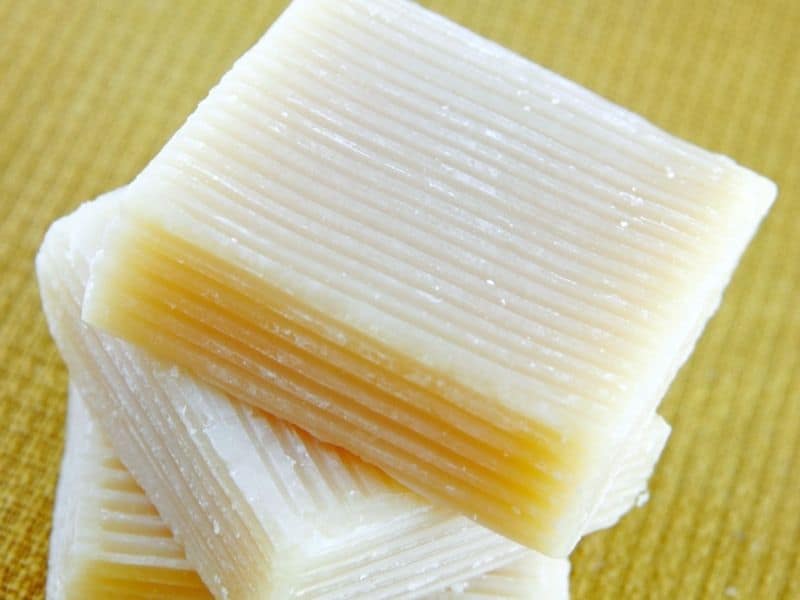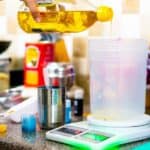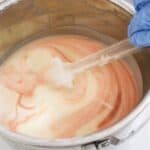Superfat or superfatting as it’s commonly called is another one of those weird words that you need to learn when you get into soap making. So, what is superfatting in soap making?
Superfat or superfatting is a soap-making process that uses less lye than the recipe requires to have leftover oil when the saponification process is complete. This helps improve the lather of the soap and makes it softer. However, it can also make it more prone to spoilage.
If you superfat your soap, it’s important to take into account that the extra oil will not be used up in the saponification process. This means that it can go rancid over time and make your soap less pleasant to use.
Superfatting is often used in handmade soaps to improve their quality. However, it’s not without its drawbacks. In this article, we’ll take a closer look at superfatting and how it affects soap making.
What Is Superfatting?
Superfatting is a term used in soap making that refers to the intentional addition of excess fat or oil in a soap recipe. This means that there is more oil or fat in the soap mixture than what is necessary to react with the lye.
As a result, there are some oils or fats in the soap that do not convert to soap during the saponification process.
Creates More Moisturising Soap
The main purpose of superfatting is to create a milder, more moisturizing bar of soap. When the lye reacts with the oils or fats, it creates soap molecules and glycerin. In a regular soap recipe, all the available lye is used up during saponification, leaving no extra oils or fats to moisturize the skin.
With superfatting, there is some extra fat or oil left over in the soap, which can provide extra moisturizing properties to the skin.
It’s A Personal Preference
The percentage of superfatting can vary depending on the recipe and personal preference. A low percentage of superfatting can be used for a cleansing bar of soap, while a higher percentage can be used for a more moisturizing bar.
However, it is important to note that too much superfatting can lead to a greasy or soft bar of soap that may not last as long.
Superfatting and Saponification
To really understand superfatting you need to understand saponification.
Saponification is the process in which the oil in your soap making recipes begins to turn into soap. This process happens when the oil is combined with an alkali (lye).
The saponification process usually takes around 24 hours to complete. During this time, the oil and lye will undergo a chemical reaction that will turn them into soap.
Once the saponification process is complete, there should be no oil left in the soap. However, if you superfat your soap, there will be some oil left over.
This oil is not used up in the saponification process and remains in the finished soap. This can add a lot of desirable benefits to the soap and make it seem more luxurious.
Superfatting and Lather
One of the main reasons why superfatting is used in soap making is to improve the lather. Soap that has been superfatted will often produce a richer and more luxurious lather.
This is because the extra oil in the soap helps to trap more air and create more bubbles. This can give the soap a fluffy and creamy texture that many people enjoy.
Superfatting and Moisturizing
Another benefit of superfatting soap is that it can make the soap more moisturizing. This is because the extra oil in the soap will help to coat the skin and lock in moisture.
This can be a great benefit for people who have dry skin or who want to use soap that will help keep their skin healthy and hydrated.
How to Superfat Your Soap
Superfatting your soap is relatively simple. You just need to use less lye than the recipe requires. Here is exactly how you superfat your soap.
Superfat your soap by using more oil or less lye. For example, if you’re making a batch of soap that calls for 300 grams of oil and 40 grams of lye. If you want to superfat your soap batch by 5% then it would be (4o grams of lye) x (1- .05) = 38 grams of lye.
It is important to remember that different types of oils will have different percentages for supergatting. Some oils need it so that the soap produced is not so harsh.
Superfatting Benefits and Drawbacks
Superfatting has its positives and its negatives. Let’s take a look.
Benefits of Superfatting Soap
There are several benefits to superfatting your soap. Superfatting can:
- Make soap more emollient and moisturizing
- Improve the quality of lather
- Reduce the amount of time it takes for soap to go rancid
Drawbacks of Superfatting Soap
There are also some drawbacks to superfatting your soap. Superfatting can:
- Make soap more prone to spoilage
- Reduce the shelf life of your soap
- Make the soap less stable
Superfatting is a process that you may want to consider if you’re looking to improve the quality of your handmade soap. Just be aware of the potential drawbacks before you superfat your next batch.
Tips For Superfatting Soap Successfully
Here are a few tips to help you superfat your soap successfully:
- Add superfatting oils at the end of the soap-making process. This will help reduce the chances of your soap seizing or going rancid.
- Start with a small amount of superfatting oil and increase it as needed. Too much oil can make your soap unstable.
- Choose an oil that is high in oleic acid for superfatting. This type of oil is more stable and less likely to go rancid.
Now that you know all about superfatting, you can decide if it’s something you want to try with your next batch of handmade soap. Just remember to take into account the potential drawbacks before you superfat your soap.
Frequently Asked Questions
A: Superfatting is the process of adding extra oil to a soap recipe. This oil is not used up in the saponification process and remains in the finished soap.
A: Superfat your soap by using more oil or less lye. For example, if you’re making a batch of soap that calls for 300 grams of oil and 40 grams of lye. If you want to superfat your soap batch by 5% then it would be (4o grams of lye) x (1- .05) = 38 grams of lye.
A: There are several benefits to superfatting your soap. Superfatting can make soap more emollient and moisturizing, improve the quality of lather, and reduce the amount of time it takes for soap to go rancid.
A: There are also some drawbacks to superfatting your soap. Superfatting can make soap more prone to spoilage, reduce the shelf life of your soap, and make the soap less stable.
Conclusion
Superfatting is a process that you may want to consider if you’re looking to improve the quality of your handmade soap. Just be aware of the potential drawbacks before you superfat your next batch. Superfatting has its positives and negatives, so choose what is best for your soap making needs.






